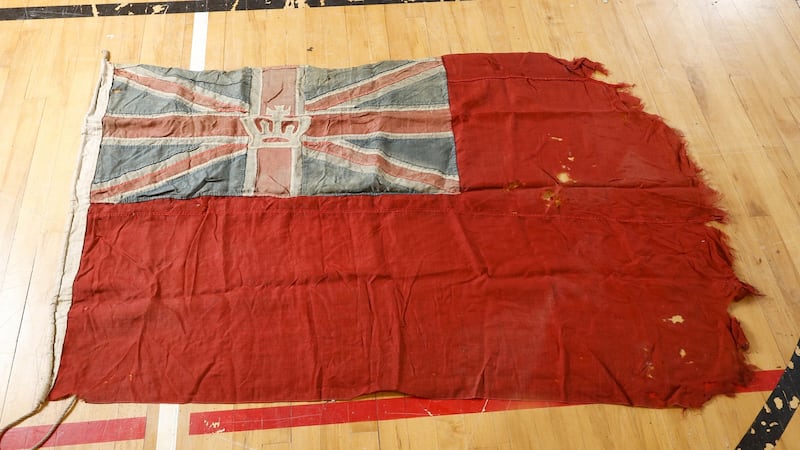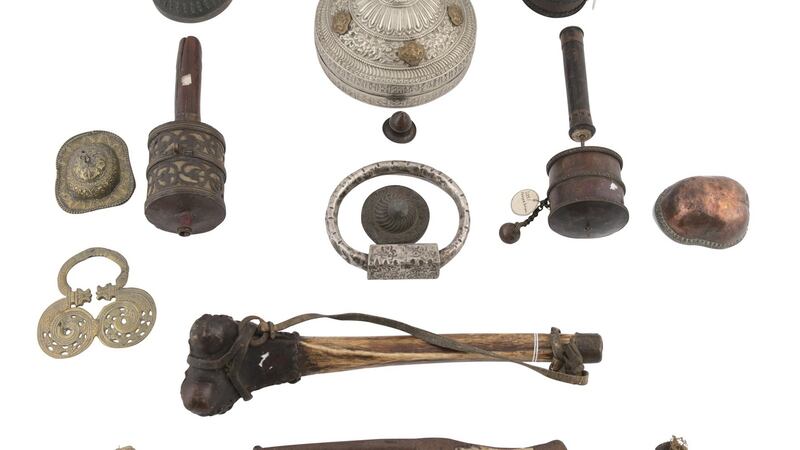One of the great things about auctions is the fascinating array of historical objects that come from Irish houses. Curiosities offered this month include a flute carved from a human thigh bone, an Irish pocket watch from a time when all Roman Catholic clergy were banished from Ireland, a rare flag from a prominent yacht club and a tablecloth presented by a light-fingered queen.
Niall Mullen describes his sale on April 13th and April 14th as "a melting pot and a snapshot of Ireland for the past 300 years". One of the more interesting legacies in the sale is that of a crocheted tablecloth embroidered with the words "welcome home". The cloth was presented to Roscommon matron Eleanor Watt by Queen Mary during her visit to British troops in the Royal Hospital in Surrey at the end of the first World War.
What makes this piece interesting is that it revives the burning question that still remains to this day about Queen Mary’s notable collection of trinkets or, more importantly, their acquisition. In the 2019 Downton Abbey film, there is a nuanced reference to small items disappearing during the queen’s visit. Debate on collectables vanishing from country homes during her visits still resonates today.
Whether she was a kleptomaniac or greedy depends on your taste in charity, but it is said, despite being a frugal royal, she meandered her way around the finest British country estates hoovering up the knick-knacks. The cloth comes with a matching tea cosy and has a €1,000-€2,000 guide price.

Yacht club flag
Also in Mullen's sale, which will be conducted and live-streamed through auctioneer Victor Mee's website, is "a rare and unique" commodores flag from the Royal St George Yacht Club in Dún Laoghaire. It dates from 1847, the year that the club, which previously bore the moniker the Royal Kingstown Boat Club, changed its name. It originates from the estate of the second Marquess Conyngham, Francis Nathaniel Conyngham, who was commodore of the club.
"I still have a portrait of him in his commodore uniform and a separate one hangs in the yacht club to this day," says Lord Henry Mountcharles of his ancestor. The flag is accompanied by a research letter from the Royal Marine Museum in Dún Laoghaire, which confirms that it is the only one in existence (€1,000-€2,000).
Lot 1 in Adam's of St Stephen's Green Library Collection sale, which is currently open and ends on Wednesday, April 14th, is a late 17th century hand-blown glass "onion" wine bottle (€200-€300). Before the 1600's, wine was stored in clay until the invention of the coal furnace, which allowed for hand-blown glass, and these bottles, known as black glass, despite being green, were easy to store and ship. While hand-blown bottles are a thing of the past, the Netflix series Blown Away – though reality television – gives an insight into the perils of working with glass furnaces that reach 1,320 degrees, which is the required temperature for its molten state.

Tibetan ritual items
Other curiosities in Adam’s sale are a rare 19th-century oak cased ballot box (€800-€1,200); a continental silver mechanical music box, from the lid of which a tiny bird pops out and sings (€1,000-€1,500) and should you need one, they also have two full suits of armour on wooden plinths (€3,000-€5,000 apiece).
But what will possibly raise most eyebrows is a small item in lot 214A, which is a collection of 18th and 19th century Tibetan ritual items. In there, along with amulets and a copper skull bowl, is a musical instrument made from a human thigh bone. Known as kangling, which literally translates as leg flute, the preferred choice of bone was that from a criminal or someone who died a violent death. Our forebears certainly had better choices for travel souvenirs than the shirts and fridge magnets of today (€400-€600).
While Ireland played a modest role in horological history, in the 18th century it became a hub for clockmakers with artisans emigrating from countries such as Germany and the Netherlands. The earliest known clock with a second hand, which is considered to be one of the most important clocks in the world, has an Irish connection as it was once part of the collection of Gertrude and John Hunt.
Mullen's of Laurel Park Three Centuries of Clocks and Watches sale, which concludes on Sunday, April 11th, covers "the age of reason to the space age". Built around a single-owner collection of an Irish musician, the earliest watch in the sale dates from the 1730s (€700-€1,000) through to a Bulova Accutron watch, which was devised with American space programmes in mind. This watch does not tick, but it hums, as it uses a tiny tuning fork instead of a balance wheel, and was one of the most accurate watches of its day (€80-€300).





















